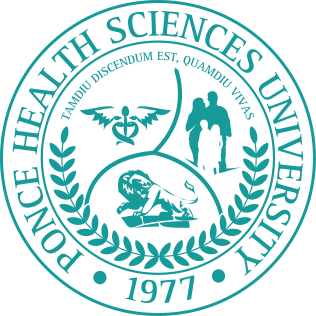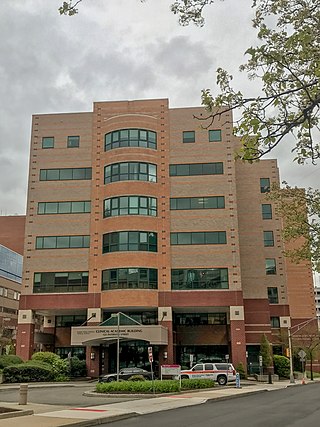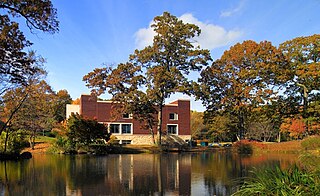Related Research Articles
The Association of American Medical Colleges (AAMC) is a nonprofit organization based in Washington, D.C. that was established in 1876. It represents medical schools, teaching hospitals, and academic and scientific societies, while providing services to its member institutions that include data from medical, education, and health studies, as well as consulting. The AAMC administers the Medical College Admission Test and operates the American Medical College Application Service and the Electronic Residency Application Service. Along with the American Medical Association (AMA), the AAMC co-sponsors the Liaison Committee on Medical Education (LCME), the accrediting body for all U.S. MD-granting medical education programs.

The Ponce Health Sciences University (PHSU), formerly Ponce School of Medicine & Health Sciences, is a private, for-profit university in Ponce, Puerto Rico and St. Louis, Missouri. It awards graduate degrees in Medicine (MD), Clinical Psychology (PsyD and PhD), Biomedical Sciences (PhD), Medical Sciences (MS), and Public Health (MPH and DrPH). The university has 360 students in its medical school and, as of 11 February 2019, was authorized to increase the student body at the medical school to 600 which, when fully in place, will make it the largest private medical school in Puerto Rico and one of the largest under the American flag.
According to the US Department of Education, the Educational Commission for Foreign Medical Graduates is "the authorized credential evaluation and guidance agency for non-U.S. physicians and graduates of non-U.S. medical schools who seek to practice in the United States or apply for a U.S. medical residency program. It provides comprehensive information and resources on licensure, the U.S. Medical Licensure Examination (USMLE), residencies, and recognition."

Medical education is education related to the practice of being a medical practitioner, including the initial training to become a physician and additional training thereafter.

The American Osteopathic Association (AOA) is the representative member organization for the more than 176,000 osteopathic medical doctors (D.O.s) and osteopathic medical students in the United States. The AOA is headquartered in Chicago, Illinois, and is involved in post-graduate training for osteopathic physicians. Beginning in 2015, it began accrediting post-graduate education as a committee within the Accreditation Council for Graduate Medical Education, creating a unified accreditation system for all DOs and MDs in the United States. The organization promotes public health, encourages academic scientific research, serves as the primary certifying body for D.O.s overseeing 18 certifying boards, and is the accrediting agency for osteopathic medical schools through its Commission on Osteopathic College Accreditation. As of October 2015, the AOA no longer owns the Healthcare Facilities Accreditation Program (HFAP), which accredited hospitals and other health care facilities.
Podiatric Medical School is the term used to designate the institutions which educate students and train them to be podiatrists, which diagnose and treat conditions affecting the foot, ankle, and related structures of the leg. In the United States, only schools which are accredited by the Council on Podiatric Medical Education (CPME) may earn the status of being a Podiatric Medical School. The Doctor of Podiatric Medicine degree is commonly abbreviated D.P.M. degree. The D.P.M. degree is a prerequisite for an individual to be accepted into a CPME accredited residency. The preparatory education of most podiatric physicians — similar to the paths of traditional physicians — includes four years of undergraduate work, followed by four years in an accredited podiatric medical school, followed by a three- or four-year hospital-based podiatry residency. Optional one- to two-year fellowship in foot and ankle reconstruction, surgical limb salvage, sports medicine, plastic surgery, pediatric foot and ankle surgery, and wound care is also available.

Rutgers Robert Wood Johnson Medical School is a medical school of Rutgers University. It is one of the two graduate medical schools of Rutgers Biomedical and Health Sciences, together with New Jersey Medical School, and is closely aligned with Robert Wood Johnson University Hospital, the medical school's principal affiliate.
The Accreditation Council for Graduate Medical Education (ACGME) is the body responsible for accrediting all graduate medical training programs for physicians in the United States. It is a non-profit private council that evaluates and accredits medical residency and internship programs.
The American Board of Medical Specialties (ABMS) is a non-profit organization established in 1933 which represents 24 broad areas of specialty medicine. ABMS is the largest and most widely recognized physician-led specialty certification organization in the United States. The other certification organizations in the United States are the American Board of Physician Specialties and American Osteopathic Association Bureau of Osteopathic Specialists.
Medical school in the United States is a graduate program with the purpose of educating physicians in the undifferentiated field of medicine. Such schools provide a major part of the medical education in the United States. Most medical schools in the US confer upon graduates a Doctor of Medicine (MD) degree, while some confer a Doctor of Osteopathic Medicine (DO) degree. Most schools follow a similar pattern of education, with two years of classroom and laboratory based education, followed by two years of clinical rotations in a teaching hospital where students see patients in a variety of specialties. After completion, graduates must complete a residency before becoming licensed to practice medicine.
Most physicians in the United States hold either the Doctor of Medicine degree (MD) or the Doctor of Osteopathic Medicine degree (DO). Institutions awarding the MD are accredited by the Liaison Committee on Medical Education (LCME). Institutions awarding the DO are accredited by the Commission on Osteopathic College Accreditation (COCA). The World Directory of Medical Schools lists both LCME accredited MD programs and COCA accredited DO programs as US medical schools. Foreign-trained osteopaths do not hold DO degrees and are not recognized as physicians in the United States or in other jurisdictions.

The New York Institute of Technology College of Osteopathic Medicine (NYIT-COM) is a private medical school located primarily in Old Westbury, New York. It also has a degree-granting campus in Jonesboro, Arkansas. Founded in 1977, NYIT-COM is an academic division of the New York Institute of Technology. Formerly the New York College of Osteopathic Medicine, it is one of the largest medical schools in the United States. As of 2023, the NYIT College of Osteopathic Medicine has a 100 percent match rate, with all members of the Class of 2023 placed into residencies, and U.S. News & World Report ranks the NYIT College of Osteopathic Medicine #49 among medical schools in the United States with the most graduates practicing primary care.
The American Medical Association (AMA) Physician Masterfile includes current and historical data on all physicians, including AMA members and nonmembers, and graduates of foreign medical schools who reside in the United States and who have met the educational and credentialing requirements necessary for recognition as physicians. A Masterfile record is created and ME number assigned when entering medical school or through the ECFMG. For medical students, there are two primary methods to create the initial record - the Student Outreach Program and the annual freshman matriculation file received from the Association of American Medical Colleges (AAMC).
Doctor of Osteopathic Medicine is a medical degree conferred by the 38 osteopathic medical schools in the United States. DO and Doctor of Medicine (MD) degrees are equivalent: a DO graduate may become licensed as a physician or surgeon and thus have full medical and surgical practicing rights in all 50 US states. As of 2021, there were 168,701 osteopathic physicians and medical students in DO programs across the United States. Osteopathic medicine emerged historically from osteopathy, but has become a distinct profession.
In 2006, hospice and palliative medicine was officially recognized by the American Board of Medical Specialties, and is co-sponsored by the American Boards of

The University of California, Riverside (UCR), School of Medicine is the graduate medical school of the University of California, Riverside, acting as one of six University of California medical schools. It enrolled its first class in 2013, with the first class of 40 medical students receiving their degrees on June 9, 2017.
The Medical School Admission Requirements Guide (MSAR) is a suite of guides produced by the Association of American Medical Colleges (AAMC), which helps inform prospective medical students about medical school, the application process, and the undergraduate preparation. The MSAR staff works in collaboration with the admissions offices at each medical school and combined B.S./M.D. program to compile information about each school and program. This data originates from a number of sources including the:

The Frank H. Netter M.D. School of Medicine at Quinnipiac University, also known colloquially as Quinnipiac Medical School, or simply "Netter," is a medical school located in North Haven, Connecticut. The medical school was established in 2010 with its first class starting in 2013.
Western Michigan University Homer Stryker M.D. School of Medicine (WMed) is a private medical school in Kalamazoo, Michigan. WMed was established in 2012 and confers the Doctor of Medicine (MD) degree, as well as Master of Science in Biomedical Sciences degree and the Master of Science in Medical Engineering degree. WMed is a collaboration between Western Michigan University and Kalamazoo's two teaching hospitals, Ascension Borgess and Bronson Healthcare. The inaugural class of 54 students started in August 2014.
References
- ↑ Glossary. ACGME website. "Archived copy". Archived from the original on 2001-04-24. Retrieved 2007-08-18.
{{cite web}}: CS1 maint: archived copy as title (link) - ↑ "Publications". LCME. Archived from the original on 2010-10-06. Retrieved 2012-06-27.
- ↑ "Directory of Accredited Programs". LCME. Archived from the original on July 21, 2011. Retrieved 2012-06-27.
- ↑ "Directory of Accredited Programs". LCME. Archived from the original on January 6, 2016. Retrieved 2012-06-27.
- 1 2 3 4 "Rules of Procedure". lcme.org. Retrieved 19 April 2021.
- ↑ Kassebaum, D. G. (February 1992). "Origin of the LCME, the AAMC-AMA partnership for accreditation". Academic Medicine. 67 (2): 85–7. doi: 10.1097/00001888-199202000-00005 . PMID 1547000.
- 1 2 "What is LCME?". Medical College of Georgia . Retrieved 19 April 2021.
- ↑ "Standards for Accreditation of Medical Education Programs Leading to the MD Degree". LCME. November 2020. Retrieved 19 April 2021.
- ↑ "LCME Accreditation". UCSF Medical Education. University of California, San Francisco. 2019. Retrieved April 2, 2020.